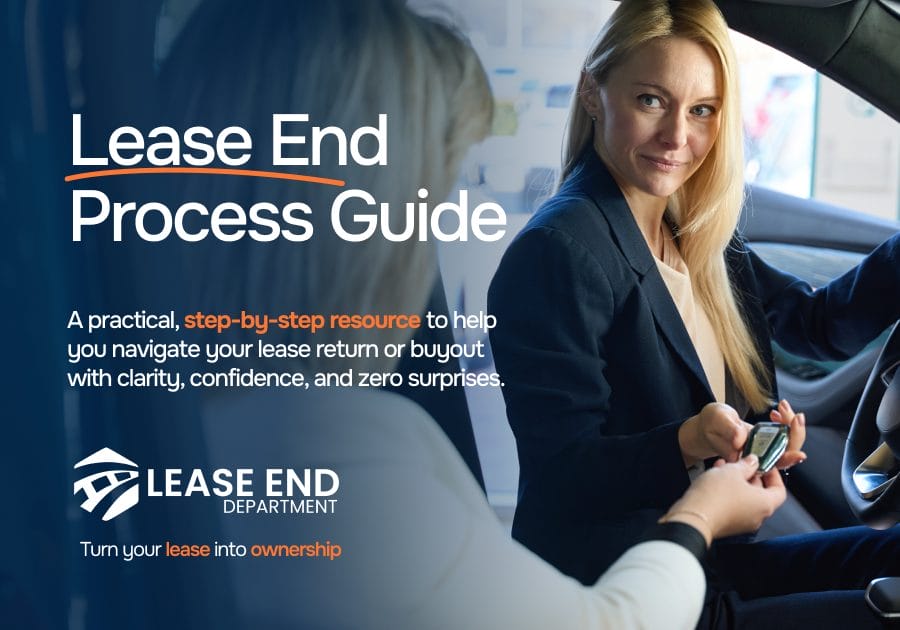End of Lease Fees: Key Takeaways
- Those surprise charges at the end of your lease? They usually cover things like wear and tear, too many miles, or missing items you forgot about, plus a bit of admin work
- There’s usually a disposition fee, which is a fancy way of saying a cleaning and processing charge, which runs about $300 to $500. Some leasing companies waive it if you stick with them for your next car
- Excess mileage charges range from $0.15 to $0.30 per mile over your limit
- Wear-and-tear fees kick in for damage like dents, bald tires, or upholstery stains
- You can reduce costs by fixing minor damage, staying within mileage, or returning the car early
- Want to avoid last-minute surprises? Schedule a pre-return inspection so you know exactly what to expect before handing over the keys
You’re nearing the end of your car lease, and you might be thinking: Can I just drop off the keys and call it a day? Unfortunately, it’s not always that simple.
Lease returns often come with unexpected charges, such as going over your mileage limit, minor dings or scratches, or even returning the car a day late.
These end-of-lease fees can add up fast if you’re not prepared.
The good news? Most of them are manageable or even avoidable if you know what to expect ahead of time.
In this guide, you’ll learn:
- What end-of-lease fees actually cover (and why they exist)
- Which fees are most common, and how much they usually cost
- How mileage overages are calculated and charged
- What counts as “excessive wear” as every scratch is not a fee)
Why End-of-Lease Fees Exist
Leasing companies expect to resell or re-lease your vehicle after you return it. The fees they charge help recover any lost value due to wear, excess miles, or missing accessories, or simply to cover the cost of preparing the vehicle for the next owner.
Those fees typically help cover:
- Vehicle reconditioning: Cleaning, minor repairs, or bodywork before resale
- Administrative processing: Paperwork, title handling, and inspection logistics
- Excess usage costs: Charges for high mileage or significant wear and tear
- Lost resale value: Damage or issues that lower the car’s market price
- Missing items: Costs to replace key fobs, manuals, or original parts
When These Fees Apply
Most end-of-lease charges typically take effect at the time of inspection or final return.
However, you may also see these fees appear:
- On your final invoice (within 30 days post-return)
- If you choose not to buy, finance, or re-lease through the same automaker
- After an off-site inspection, if additional damage is found
Can You Avoid Them?
Some fees you can sidestep, others you’ll have to navigate more carefully.
Here are a couple of common scenarios you might find yourself in:
- Disposition fees are sometimes waived if you lease another vehicle from the same brand
- Wear-and-tear and mileage fees can be reduced by maintaining the vehicle and staying within mileage caps
- Missing equipment fees are easily avoidable if you return everything that came with the car


Common Fees When Returning a Leased Car
Most lease agreements come with several end-of-term fees designed to cover wear, mileage, and processing costs.
When lease return day rolls around, these are the charges that tend to show up most often.
Disposition Fee
This is a standard administrative fee charged by the leasing company to cover the cost of cleaning, transporting, and reselling the vehicle after you return it.
- Typical cost: $300 to $495
- Can you avoid it? Sometimes, many lenders waive this fee if you lease or purchase another vehicle from the same brand.
Excess Mileage Charges
Every lease has an annual mileage limit (usually 10,000–15,000 miles). If you exceed that limit, you’ll be charged for each extra mile.
- Average charge: $0.15 to $0.30 per mile
- Example: Go 3,000 miles over your limit at $0.25/mile? That’s $750 in overage fees.
Tip: Keep an eye on your mileage. If it looks like you’ll go over, give yourself a few months’ head start to figure out your options.
Excessive Wear-and-Tear Fees
Lenders expect some minor scuffs and wear, but anything beyond “normal use” can trigger charges.
Common examples that go beyond normal use are:
- Dents larger than a credit card
- Deep scratches
- Stained or torn upholstery
- Cracked windshield
- Bald or mismatched tires
Tip: Many brands offer a wear-and-tear inspection before your return date, take advantage of it.
Missing Equipment or Accessories
If you return your car without essential items, you’ll likely get charged.
What counts as “missing”?
- Spare key or key fob
- Floor mats
- Cargo cover
- Original manual
- Charging cable (for EVs)
Late Return Penalties
If you miss your lease-end date, you can expect daily or monthly extension fees. Some contracts automatically roll you into a month-to-month lease if you don’t act on time.
Tip: Set reminders 30–60 days before your return date to schedule your inspection and return on time.
How Excess Mileage Charges Work
Your lease will set a mileage limit, which is often 10,000, 12,000, or 15,000 miles per year. If you overshoot that number, you’ll owe for the extra miles, and that’s one of the more expensive surprises people run into.
How It’s Calculated
The leasing company tracks the total mileage you were allowed over the full lease term and compares it to the car’s odometer at return.
Example:
- 36-month lease × 12,000 miles/year = 36,000 allowed miles
- Return the car with 39,500 miles? You’re 3,500 miles over
Typical charge:
- $0.15 to $0.30 per extra mile, depending on the brand
- In the above example, 3,500 miles × $0.25 = $875 in mileage fees
Ways To Avoid or Reduce Mileage Charges
- Track your mileage early. If you’re trending over, start planning 3–6 months before lease-end.
- Consider a lease buyout if your car has equity; you may save money and keep the vehicle.
- Explore a trade-in with a third party like Carvana, Vroom, or Lease End Department.
- Ask about prepaid mileage. Some lenders let you buy extra miles upfront at a lower rate.
- Park the car early. If you’re well over, consider using a second vehicle for the final months.
What Counts As “Normal” vs. “Excessive” Wear?
While every leasing company defines these terms slightly differently, here’s a general rule of thumb:
| Normal Wear (No Fee) | Excessive Wear (May Trigger Fee) |
| Minor scuffs or paint chips | Dents larger than a quarter |
| Light tire wear | Bald tires or mismatched sets |
| Small fabric creases | Stains, rips, or burns in upholstery |
| Clean windshield | Cracks, deep chips, or starbursts |
| Intact panels | Deep scratches, bumper damage |
Common Damage That Leads to Fees
- Dents, dings, or scratched paint
- Curb rash on wheels
- Cracked or chipped windshields
- Interior stains, burns, or tears
- Worn-out or uneven tire tread
- Broken or missing accessories (e.g., headrests, knobs, mats)


How Lease End Department Helps You Avoid Surprise Fees
Returning a leased car shouldn’t come with surprise charges or confusing fine print. Not sure how to handle lease-end fees? That’s where Lease End Department comes in, we make sure you’re not caught off guard.
Here’s how we can help:
- We’ll walk you through potential end-of-lease fees before they happen
- We’ll check if your lease qualifies for a third-party buyout and show you the numbers
- We’ll handle DMV paperwork, title transfers, and more that’s all 100% online
Plus, we specialize in lease buyouts for popular brands, including:
Whether you’re looking to return, keep, or sell your leased vehicle, we’ll help you make the smartest move with zero pressure and full transparency.
End of Lease Fees: FAQ
What fees should I expect when returning my leased car?
You’ll probably see a disposition fee on your final bill, and maybe a few extra charges if the car’s been through more than usual. The good news? Most of it’s avoidable with a little planning.
How much is the typical disposition fee?
Most are in the $300 to $500 range. It’s basically the leasing company’s way of covering their costs to resell or clean up the vehicle. Some brands waive it if you lease or buy another car from them.
What exactly counts as “excessive” wear and tear?
Think dents bigger than a credit card, major scratches, bald tires, or any damage you’d raise an eyebrow at if buying the car yourself. A little wear is okay as you’re not expected to return it showroom-new.
Can I avoid paying excess mileage fees?
Sometimes. If you’re close to the limit, you can park the car early, use another vehicle, or look into lease buyout options if the car has equity. Some leases also let you buy miles upfront at a lower rate.
What happens if I’m missing something like a key fob or manual?
You’ll probably be charged for it. Even small items such as floor mats or cargo covers can trigger a “missing equipment” fee, so ensure that all original equipment you received at the start is still with the car.
Is it better to buy the car instead of paying end-of-lease fees?
It depends! If your car’s worth more than the buyout price, buying it might be a smarter move, especially if you’d owe fees anyway. Lease End Department can help you crunch the numbers and compare options.



